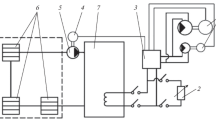Conclusions
-
1.
In a pump regime the discharge openingsoperate full section at a height h≤(0.2–0.3)dc; separation of the flow from the sill of the openings occurs at larger values of h. For tower diameter Dtw=2dc the height of the throughgoing flow increases slightly at the exit with increase of the the height of the discharge openings to h<0.6dc and for Dtw≥3dc it decreases. When h≥0.6dc the height of the throughgoing flow is constant and at the exits is about (0.55–0.6)h for Dtw=4dc, (0.27–0.35)h for Dtw=3dc, and (0.18–0.22)h for Dtw=4dc.
During operation of the discharge openings full section (\(\bar h\) ≤ 0.3), an increase of the tower diameter is accompanied by an increase of nonuniformity of the distribution of velocities over the height of the openings; the opposite picture is observed with the occurrence of separation of the flow from the sill, i.e., for\(\bar h\) > 0.3.
-
2.
In the pump operating regime for a height of the openings h≥(0.5–0.6)dc, the intakes/outlets with an outside diameter of the discharge openings Dtw=2dc have smaller values of the resistance coefficients (by 0.02–0.06) than for Dtw≥3dc, and for h<(0.5–0.6)dc intakes/outlets with a tower diameter Dtw≥4dc are preferable with respect to head losses.
-
3.
In a turbine regime without trash racks, smaller head losses are observed in intakes/outlets with Dtw≥3dc; a decrease of the tower diameter to Dtw=2dc leads to a considerable increase of the head loss coefficient: by 0.05–0.18 in the range of heights of the openings h=(0.6–0.3)dc; the presence of trash racks of the same height leads to an increase of the resistance coefficient of the intake/outlet with Dtw=2dc.
-
4.
With consideration that with a change in the outside diameter of the discharge opening, the increase of the head loss coefficient with increase of their height in the pump regime changes in magnitude and signt and also that investments in construction depend on the outside diameter of the discharge openings (tower), the final choice of the size of the intake/outlet can be made only on the basis of a technicoeconomic comparison of variants with the use of the results of the studies presented in this article.
Similar content being viewed by others
Literature cited
I. E. Mikhailov, Yu. V. Polikarpov, A. K. Fink, and A. V. Morozov, “Effect of the size of discharge openings on the characteristics of a tower (shaft) type of water intake/outlet for a pumped storage station,” Gidrotekh. Stroit., No. 9 (1991).
M. M. Nosova, “Resistance of entrance and exit pipes with a shield,” Promysh. Aerodin., No. 7 (1956).
I. E. Idel chik, Handbook of Hydraulic Calculations [in Russian], Mashinostroenie, Moscow (1975).
V. I. Zolotukhin, “Hydraulic investigations of water intake tower structures,” Candidate Dissertation, Rovno (1983).
Additional information
Translated from Gidrotekhnicheskoe Stroitel'stvo, No. 3, pp. 31–35, March, 1982.
Rights and permissions
About this article
Cite this article
Mikhailov, I.E., Polikarpov, Y.V. & Fink, A.K. Experimental investigations of water intake/outlet towers (shafts). Hydrotechnical Construction 26, 176–183 (1992). https://doi.org/10.1007/BF01876916
Issue Date:
DOI: https://doi.org/10.1007/BF01876916




